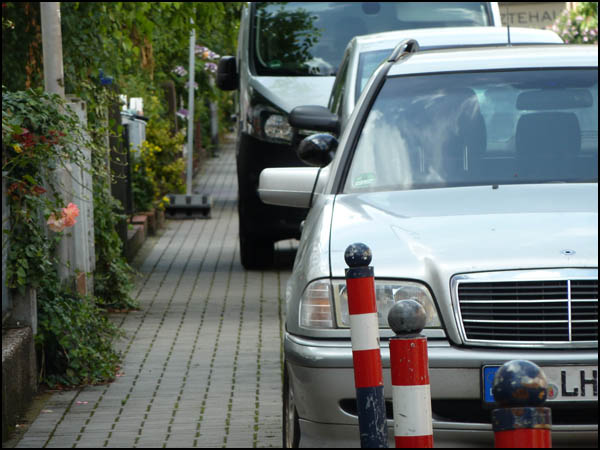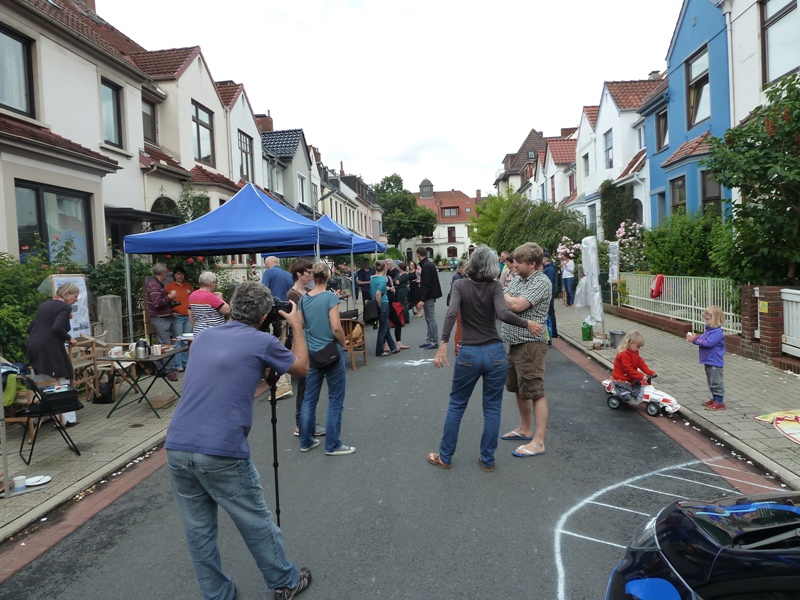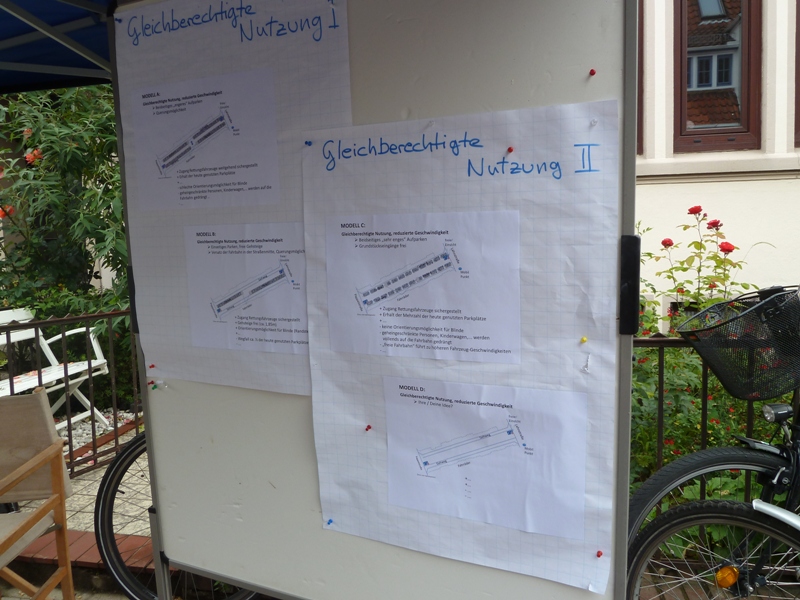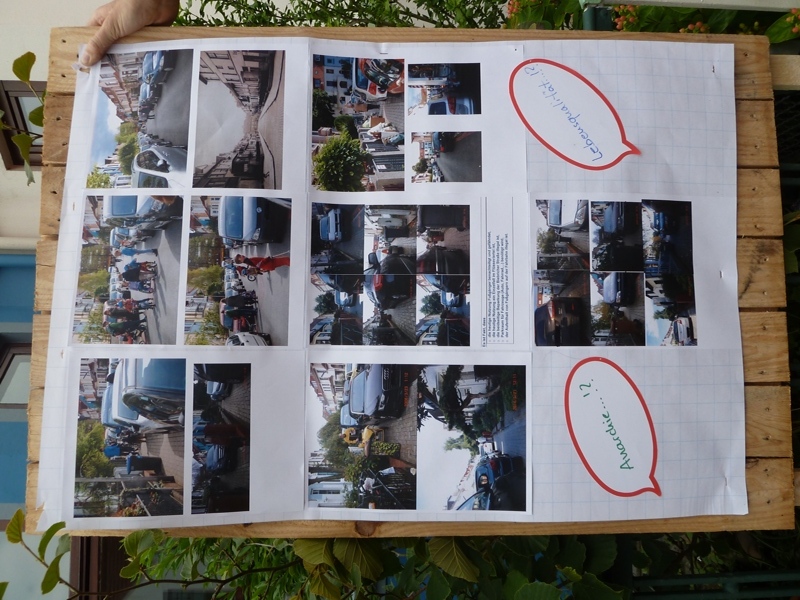The new Draft Agreement on Cooperation in a Government Coalition for Bremen, 2019-2023 (from now on here called Koa Treaty) promises to install resident parking, to ban illegal parking and to push back the illegal practice of parking on pavements with two wheels. Hooray! Or not to Hooray?
It literally says: “We will consistently manage public parking space, i.e. we will manage the inner-city areas and identify resident parking.”
But we have to be careful: resident parking in Germany is super cheap. What is the upshot?
Resident Parking is a bargain in Germany
In Germany you pay (an admin fee) at the very most 30,70€ per year for the right to park your car where resident parking schemes exist. This is a cheap bargain. Buy one (car) get one (parking space) free.
· Will this policy animate people to get rid of their cars and to use sustainable transport modes including Carsharing or join Car Clubs to share cars?
· Will it solve the problem of disproportionate or even unfair space use by car owners?
· Will we have a better quality of life in our residential areas?
· Will this policy simply develop appeasement zones for residents’ cars to make car ownership as comfy as possible?
Of course my questions are just rhetorical, we all know that, our politicians know that, no matter where you are, in Berlin or in Bremen. But still the Federal Government in Berlin does not seem ready to change the law, and local initiatives will not be able to instigate a change in the short run. So we need other concepts for our residential areas, concepts that do not simply rely on monetary disincentives but more so on qualitative offers and tangible disincentives. This of course is applicable worldwide, not just to Germany.
Barriers to improve quality of life
What we see in every densely inhabited quarter in Bremen are citizens‘ initiatives fighting against the masses of parked cars, the high speed of through traffic and the inconsiderate habits of car drivers who park their cars willy-nilly. But these initiatives are also forced to fight against their car loving neighbours and lethargic councils.
Very often these citizen activists are young parents or grandparents, who are fighting for space for their kids, but also other residents have had enough daily dodging of cars. They call for resident parking, for parking management, for so called temporary play streets and a new design for their streets and neighbourhoods.
Sophisticated resident parking
That is why the aim of resident parking cannot just be „Leave everything as it is, allowing residents to park everywhere but not visitors. Protect us from through traffic and parking scofflaws“. In other words: Give us a convenience zone for our cars, a comfort zone for residential motorists. This is unacceptable. No, we need to improve the situation for kids and pedestrians, to transform our neighbourhood into one designed for people. We need ambitious or better: sophisticated resident parking.
In the face of a traditional, car-oriented federal law which only permits for disproportinally low fees for resident parking we have to search for other, accompanying alternative measures if we want to free our neighbourhoods from the never-ending car tsunami. Note: low prices for parking in public spaces subsidises car owners, every tax payer pays for his or her neighbour’s free parking space.
Two courses of action are possible here:
1. We have to expand the toolbox of monetary measures of classical resident parking (1 parking space = € 30,70 per year) by steering measures, thus moving away from traditional car owners‘ privileges and make car ownership less attractive.
Or/and
2. We have to reshape residential areas or neighbourhoods
1: Steering measures
1. Reduce the amount of parking allowances per household or property: only 1 per house, or better 0.5 or 0.3
2.Reduce the amount of legally usable parking lots or replace every 10. or 5. lot by a row of cycle stands
3. Install visitors‘ parking lots with parking meters
4. Install rows of cycle stands on the road space including special stands for cargo bikes
5. Install Carsharing stations and remove at least 10 illegal car parking spaces for every station with physical measures like bollards
6. Hand out information about alternative parking possibilities in parking garages near the residential area
7. Remove the duty to provide parking spaces for cars in the city, change the law accordingly
8. Last not least: disable legal parking in general
And hooray, the Koa Treaty shows some consideration for these ideas:
„In view of the urban area shortage and in order to increase the quality of stay, we will need public space previously used as parking space for other road users and free- and play- areas. We also want to make more space available for bicycle parking and mobile points for car sharing.” (p. 40)
“We will consistently prevent illegal parking, especially at junctions. We want to push back the illegal practice of parking on pavements; to this end we will see consultation with the local councils (Beiräte). Here also resident parking will be installed.” (p. 41)
“We will modernize the parking space regulation with the aim of replacing a compulsory share of the parking spaces with mobility management measures such as car sharing or season tickets (public transport) for each construction project. This facilitates low-car or car-free housing projects.” (p. 41)
2.: Reshape residential areas
Sophisticated residential parking is also the aim of a group in Hanover. The Jamiel-Project has taken projects in Catalunya e.g. in the cities of Barcelona and Vitoria-Gasteiz, the so called super blocks, as its role models. The activists behind Jamiel have already put a lot of creative planning into their three streets (Jacobsstraße, Minister-Stüve-Straße and Eleonorenstraße), they have organised street parties and fun activities but they are also suffering from typical neighbour NIMBY activity. More information here (in German).
And our lessons?
First and foremost: densely inhabited quarters, where people are suffering from the presence of too many cars could be reshaped into „super blocks“ as in Catalunya. These then also need more measures to be implemented:
1. Stop through traffic by putting physical barriers into the middle of the street, set up one way systems that make simple through traffic unattractive and more
2. Reduce speed limits to 10 km/h
3. Install temporary play streets: E.g. on Mondays Street A, Tuesdays Street B, Wednesdays Street C and D and so on.
Epilogue
Folks, please keep in mind that we are not calling for revolution. But we are also not alone in demanding Transport Transition. In many German cities new initiatives for cycling are growing like Radentscheid Hamburg.The most famous of these is the Berlin Citizens‘ Initiative for Cycling, which today is called Changing Cities. In many German cities new initiatives for cycling grow constantly The Umweltbundesamt published their proposals in their studies „Geht doch“ and „Die Stadt von morgen“. And „Jan Gehl in Copenhagen“ calls out for „Cities for People“.
Let’s get going. Now or never.






0 Comments